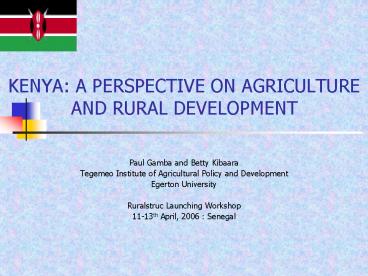KENYA: A PERSPECTIVE ON AGRICULTURE AND RURAL DEVELOPMENT PowerPoint PPT Presentation
1 / 17
Title: KENYA: A PERSPECTIVE ON AGRICULTURE AND RURAL DEVELOPMENT
1
KENYA A PERSPECTIVE ON AGRICULTURE AND RURAL
DEVELOPMENT
- Paul Gamba and Betty Kibaara
- Tegemeo Institute of Agricultural Policy and
Development - Egerton University
- Ruralstruc Launching Workshop
- 11-13th April, 2006 Senegal
2
OUTLINE
- Background on Kenya
- Basic Facts on Agriculture and Rural Development
- Evolution of Agricultural and Rural Policies
- Major challenges facing Agriculture and rural
Development - Vision of the future
3
Background on Kenya
- Located on the equator in Eastern Africa,
- Land Size582,650 sq km
- Increasing Population
- 1979 15million
- 1989 21 million
- 1999 28 million
- 2006-est. 32 million
- Pop. Below poverty 56
- GDP 16.25 billion (2005 est.)
- agriculture 16.3 industry 18.8 services
65.1 (2004 est.) - GDP Growth rate 4.3 (2004)
4
Background on Kenya Cont..
- varied Agro-ecological Zones
- Rainfall Ranges from 400mm to more than 2000mm
- Some areas experience two rainy seasons
- Temperature range 100C to more than 300C
5
Basic Facts on Agriculture and Rural Development
- Agricultural Land classified into High, Medium
and Low potential based on Rainfall - Dual Agricultural Sector
- Subsistence and Commercial
- Large Scale and Smallholders
- Smallholders account for 70 of gross marketed
production
6
Basic Facts on Agriculture and Rural Development
Cont
- Major Agricultural Commodities
- Cereals and legumes maize, wheat, barley, rice,
beans - Industrial Sugar cane, Tobacco, Pyrethrum
- Horticultural Tropical fruits, vegetables and
flowers - Perennial Crops Tea, coffee, coconuts, cashew
nuts
7
Basic Facts on Agriculture and Rural Development
Cont
- Major Export Crops
- Tea, Horticultural crops (Flowers, fruits and
vegetables), Coffee, pyrethrum - Declining productivity
- Increasing food imports
8
Trends in Maize Production and Productivity
Production has been on an upward trend but the
increases are marginal and cannot cope with
population growth
9
Maize Production versus Consumption
10
GDP and Agricultural GDP Growth Trends
11
Evolution of Agricultural and Rural Policies
- Colonial period (Before 1954)
- Scheduled areas and scheduled crops
- Restricted Marketing
- Government assistance directed toward settler
farmers
12
Evolution of Agricultural and Rural Policies
- The Swynnerton Plan Period (1955 1962)
- Opening up of commercial farming
- Land tenure issues addressed through
Consolidation and registration - Opening up of agricultural produce marketing
13
Evolution of Agricultural and Rural Policies
- Early Independence Period (1963 1982)
- Land sub-division and emergence of smallholders
- Heavy government involvement (input supply,
marketing boards) - Rapid growth of the agricultural and rural
sectors
14
Evolution of Agricultural and Rural Policies
- Liberalization Era (1983 2002)
- Government withdrawal from service provision
- Outdated legislation, institutions and
inappropriate regulatory structures - Increased private sector involvement
- Decline in productivity and loss of
competitiveness - Increased poverty levels
- Emergence of off-farm income and remittances
- Development of Poverty Reduction Strategy Paper
(PRSP)
15
Evolution of Agricultural and Rural Policies
- Recovery Era (2003 and after)
- Development of Economic Recovery Strategy (ERS)
and Strategy of Revitalizing Agriculture (SRA) - Increased democratization
- Slow Legal, regulatory and institutional reforms
- Emergence of strong stakeholder lobby and
advocacy - Policy reversals for example KCC, KMC
16
Major Challenges Facing Agriculture
- Improving productivity and competitiveness
(regional and global) - Attraction and maintenance of private resources
into agriculture - Restoring government support in the provision of
public goods (infrastructure, epizootic livestock
diseases )
17
Thank You(Ahsante)

